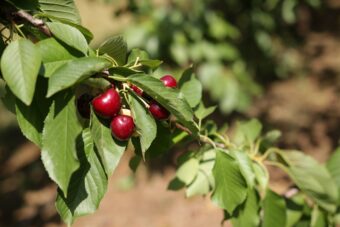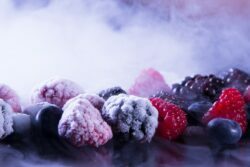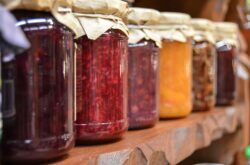In this article, we will talk about how to harvest your home-grown fruit, how to determine it is ready to harvest and what to do to store your little treasures.

We, home-grown gardeners, work hard throughout the growing season and when harvest time comes the reward of all the hard work comes to fruition and you can enjoy them. Most fruits are best eaten straight picked from the tree, shrub or canes, ideally within hours. After all, it is the main reason we grow them but often there are gluts and we must store fruit. This is the best way to get rid of less than perfect produce, as it can be made into pies, puddings and jams.
WHEN TO PICK FRUIT
You cannot tell if a fruit is ready to pick by looking at them, but if you want to know if the fruit is ready by the way its smells and how easy it comes away from the plant. Most fruit will need to be picked that way but some fruit like later ripening apples and pears need to be picked before they are ready to eat.
There will be variation in how and when to harvest fruit, but the following can be used as a general guide:
COLOURS AND TEXTURE
Most fruits will change colours to a warmer, richer and darker shade as it ripens. For some soft fruits, such as raspberries and currants, it is best to wait an extra day or two to allow the flavours to develop further. They may appear ripe but they will not taste ripe.

When you squeeze a fruit, you will often find that they feel softer when ripe to when it is unripe. The trouble with this is that apples will not have any noticeable changes. Plums, apricots, peaches and nectarines, on the other hand, will move if you press the skin. If these fruits feel firm then they are not ready.
It takes time to learn this but do not squeeze too hard, as this will cause bruising and will spoil the fruit.
As ever, there are exceptions like pears and medlars that are picked hard and ripened at home ready for eating.
ODOUR AND EASE OF REMOVAL
If you smell the fruit and it does not have much of a smell then it is probably not ripe. Leave it and wait another day. This is, of course for those who have a good sense of smell. If you have sinus problems then this could be a problem.
A fruit that is ready for picking tend to come off easily from the bush, tree or cane without much effort, Raspberry and blackberry come off the inner core with a little tug, if they are stubborn and do not want to come off, then the berry is not ready.
Again, they are exceptions to these rules as melons and passionfruit must be picked with a short stem to avoid damaging the rest of the plant. One thing that must be remembered is that not all the fruit will ripen in one go, you will need to check regularly and pick them as soon as they are, as they can spoil quickly. This can be problematic with plums where large gluts can often occur.
STORING FRUITS
The good news unless you have plenty of soft fruit, it is unlikely that you will need plenty of room for storage. It is best not to be tempted to grow more than you can consume. This does not mean that they cannot be stored, but soft fruits like raspberries, blackberries, and other berries can be frozen and stored for use over winter. Best enjoyed fresh but they is nothing like a crumble, pie or fool in the dead of winter.

To freeze, you must choose healthy and firm fruit, not soft, diseased fruit. You must wash it to remove any pests and residue and that it is thoroughly dried before it is placed in the freezer. Spread the fruit out and place the fruit on a single layer on a clean tray where it will be quickly frozen in a freezer. Once the fruit has frozen, you can place them in freezer bags ready for storage,
Blackberries, blueberries, cranberries, currants, gooseberries, mulberries, raspberries and strawberries can be frozen without any form of processing. Frozen strawberries can become soggy, so do not expect to have a good texture to them.
Apricots, cherries, plums, peaches and nectarines will need the stones to be removed before they are frozen. This is easier to do if you stew them and then sieve the stones out. Rhubarb will need to be blanched before freezing, otherwise, it can be ruined.
STORING PEARS AND APPLES
Pears and late-maturing apples must be picked before they turn ripe and they must be allowed to ripen undercover. It is best to use a storage box like they used to do and wrap the fruit individually in a sheet of newspaper.
This is important as it will prevent them from drying out and becoming wrinkled. One thing that must be considered is the rotting of the fruit in storage, especially if they get damp. A newspaper will help to stop this but not totally eliminate it.
This is why stored apples and pears will need to be checked regularly. Pests, especially rats and mice will be attracted to the fruit as it ripens, so it is advised to place so form of traps to help guard your harvest.
As said earlier, you need to check the fruit regularly, as there is a chance that they will start to rot in storage. These will need to be removed as soon as observed, otherwise, they can affect other fruits which are close by.
MAKE JAMS, PRESERVES OR CHUTNEYS
This is a great use of damaged and small fruit as no one will be the wiser. When jam is made properly it will have the flavour of the original fruit and should be far superior to shop-bought stuff.

It will have plenty of sugar in it, often on the ratio of 1kg of sugar to 1kg of fruit (destoned and pits removed). Almost all fruits can be used to make jam, although with apples and pears it is best to combine with berries to avoid making a thick purée. A great alternative and much spicier option is to make chutney.
You noticed when jam making is the amount of pectin the fruit contains. Some fruit will have plenty of pectin and will set easily, whilst others have little pectin and therefore will never set without help. To get it to set then you will need to use jam sugars that contain pectin to do this. Easy fruit to make jams include blackcurrant, red currants and loganberries, whilst strawberries and blackberries will need help. Plums can be a double-edged sword, as some varieties will set without extra pectin, whilst others will need help.
If you are lucky enough to have a large glut of apricot, it is better to cut them in half and preserve them in brandy ready to eat for Christmas. Cherries can be treated in the same way. Makes a great homemade Christmas gift as well.
CONCLUSIONS
In this article, we have discussed how to know if your fruit is ready to harvest and what to do with your gluts. If you know what to do in terms of what to look for in colour, texture, smell and how easy it is to pick, then you will soon be a harvesting expert. For gluts, it is best to either store, freeze or makes jams for which you can use throughout autumn and winter.
You now know what to do with your produce. If you have any questions or comments that you like to make on harvesting fruit, please do so in the comment box below.
Happy fruit-eating and harvesting.
